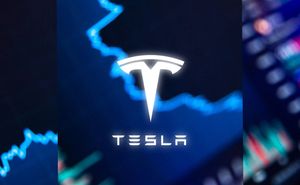The "Strategic Analysis of the Connected Car Regulations, Global, 2025" report has been added to ResearchAndMarkets.com's offering.
This study analyzes the regulatory framework of the connected vehicle sector's various segments in Europe, North America, and China.
The increase in embedded navigation systems and 5G technology will drive several new CV features through an app or service. The deployment of over-the-air (OTA) software updates and personal information sharing for a personalized experience will grow. This technological shift will require regulations to prevent security risks, such as unauthorized access to personal data, fraudulent transactions, and identity theft.
This research discusses regulations/standards on the following technologies: eCall, next-generation (NG) eCall, vehicle-to-everything (V2X), cellular-V2X, cybersecurity, 5G connectivity, personal data security, intelligent speed assistance (ISA), web services, and internet of vehicles (IoVs).
The Impact of the Top 3 Strategic Imperatives on the Global Connected Car Regulations
Transformative Megatrends
Why: The integration of advanced technologies, automation, data collection, and the evolution of transportation systems is a primary driver in the automotive industry. The widespread adoption of connected, autonomous, and electric vehicles (EVs) is a key trend that directly influences regulatory frameworks.
The rise of AI, 5G networks, autonomous driving, IoT integration, and smart cities is transforming how vehicles function and interact with their surroundings, creating the need for new regulations in the connected car space.
Analyst Perspective: As connected and autonomous vehicles advance, regulations must address cybersecurity, safety standards, and traffic management. Key frameworks are expected by 2025 to 2027, coinciding with the L4 autonomy rollout.
Strict privacy laws and global standards are necessary for 5G and V2X technologies as they generate massive personal and geolocation data. Many interoperability policies will likely be announced in the next 2 to 3 years as 5G and V2X spread widely.
Internal Challenges
Why: As the market for connected, autonomous, and EVs grows, automakers, technology companies, and other stakeholders compete to lead in innovation, technology, and market share, creating challenges in shaping the regulatory environment.
Lack of harmonization in regulations across different regions creates significant challenges for compliance. Each country or region develops its own regulatory framework, resulting in inconsistent standards globally.
Analyst Perspective: Over the next 2 to 3 years, facilitating data sharing and transparency among stakeholders will help regulators make informed decisions and enable industries to achieve emerging standards more efficiently.
Encouraging the development of universal standards for connected, autonomous, and electric vehicles would help align methodologies such as the United Nations Economic Commission for Europe (UNECE) and other global collaborations across borders in the next 5 years.
Competitive Intensity
Why: Companies strive for competitiveness through innovation in connected car technologies, such as autonomous driving, AI, and IoT, which push the boundaries for other stakeholders to adapt quickly to the changing dynamics.
As the connected car market evolves, consumer demand for advanced features, including personalized experiences and seamless device integration, will increase. Competitive pressures may lead companies to compromise on regulations to accelerate their product rollouts.
Analyst Perspective: By 2030, innovation in the automotive industry will focus on safeguarding consumer data and engaging with regulators to form standards that balance technological progress with risk management.
By 2030, automakers and stakeholders will prioritize customer experience, sustainability, and safety while aligning with global long-term goals such as carbon emission reduction. This will allow them to contribute significantly to environmental and economic progress.
Growth Restraints
Global Standardized Gaps
Countries adopt different approaches to connected car regulations, creating inconsistencies in standards for autonomous vehicles, cybersecurity, and data protection. This makes compliance challenging for automakers and suppliers operating in diverse regions.
Infrastructure Development
Adoption of connected vehicles depends on 5G, V2X communications, and smart city infrastructure, which many regions lack, creating a barrier to adoption and regulations. Without proper infrastructure, regulatory bodies face challenges defining and enforcing rules for vehicle communication, autonomous operations, and smart city integration.
Cybersecurity and Data Privacy
Rising cybersecurity threats and data privacy concerns are major challenges for connected cars, as vulnerabilities to vast amounts of user data generated raise risks to vehicle safety and privacy. Ensuring cybersecurity, addressing data privacy regulations around cross-border data sharing, and gaining consumer consent could slow adoption.
External Factors
Geopolitical factors, including the ongoing tariff wars and rising fuel and energy prices, have detrimental impacts on sales and revenue growth for global OEMs, slowing innovation and the rollout of new technologies in line with regulatory developments. Additionally, the after-effects of the pandemic continue to impact market growth in regions such as China.
Growth Drivers
Consumer Demand for Advanced Features
Consumer demand for personalized in-car experiences, seamless mobile integration, and real-time traffic updates will promote the integration of more connected car features inside vehicles. This growth will be accompanied by evolving regulations to ensure data security and transparency.
Technological Advancements
The 5G rollout and the rise of autonomous vehicles, AI-driven systems, and EVs drive significant automotive advancements. This requires evolving regulations to address safety, liability, data privacy, and grid interoperability, ensuring secure and efficient connected car technologies.
Harmonization of Regulations
As connected car technologies expand globally, the need for regulatory alignment increases. For instance, standardizing cybersecurity, data privacy, and communication protocols across regions will ensure that connected vehicles can operate safely and seamlessly in different markets.
Environmental and Sustainability Goals
The push for green transportation and emission reductions is prompting regulatory changes to integrate connected cars into sustainable systems, with stricter emission standards, EV adoption incentives, and carbon reduction targets driving new regulations.
Key Topics Covered:
Evolution of Connected Car Regulations in the Automotive Industry
Why Is It Increasingly Difficult to Grow?
- The Strategic Imperative
- The Impact of the Top 3 Strategic Imperatives on the Global Connected Car Regulations
Ecosystem
- Scope of Analysis
- Key Findings
- Connected Vehicle Ecosystem
- In-vehicle Data
- Notable Global Automotive Cyberattacks
- Global Regulatory Overview: Global
- Regulations, Standards, and Policies by Region
- Upcoming* Regulations, Standards, and Policies by Region
Growth Environment: Impact of Connected Car Regulations in the Automotive Industry
- Growth Drivers
- Growth Restraints
Connected Vehicle Regulations: Europe
- Highlights of Key Regulations and Standards in Europe
Personal Data Privacy and Security: Europe
- General Data Protection Regulation GDPR
- GDPR: Legal Terms
- GDPR: Data Protection Principles
- GDPR: Automotive Ecosystem
- GDPR in Focus: Current Landscape and Impacts
- Data Governance Act DGA
- Emerging Regulations on Data Protection
- Summary of Data Privacy Laws Update
eCall Mandate: Europe
- eCall Mandate
- eCall Mandate: Privacy And Data Protection Rules
- eCall Mandate: GDPR Implementation
- Next Generation eCall NG-eCall
Intelligent Speed Assistant ISA Regulations: Europe
- ISA Regulations
Cybersecurity: Europe
- UNECE WP.29: Cybersecurity in Connected Vehicles
- WP.29 Regulation: Principles
- WP.29 Key Requirements and Mandates
- R155: Cybersecurity Management System CSMS by UNECE
- R155: UNECE Cybersecurity Regulation
- R156: Software Updates and Software Update Management System SUMS by UNECE
- R156: Software Updates and Software Update Management Systems SUMS
- R155 and R156: A Comparative Overview
5G Connectivity: Europe
- Case Study: 5G Cross-border Control 5GCroCo Trial and Tests in Europe
- 5G: Policies and Standards in Europe
Cellular Vehicle-to-Everything C-V2X Deployment: Europe
- C-V2X at 5.9 Gigahertz GHz
- C-V2X and DSRC: A Comparative Overview
- C-V2X: Key Allocation Band Configuration Deployment
- Impact on Automakers in Europe
Connected Vehicle Regulations: North America
- Highlights of Key Regulations and Standards: North America
- Connected Car Standards Overview: North America
Personal Data Privacy and Security: North America
- Implementation of the National Data Privacy Law
- Distribution of Privacy Laws by US State
- California Consumer Privacy Act CCPA: Automotive
- CCPA 2.0 or California Privacy Rights Act CPRA
- CCPA and CPRA: A Comparative Overview
- Virginia Consumer Data Protection Act VCDPA
- Colorado Privacy Act CPA
- PIPEDA* Personal Data Act: Canada
- PIPEDA Updates: Canada
- Summary of Data Privacy Laws: Canada
- LFPDPPP* Personal Data Act: Mexico
- Personal Data Act Updates: Mexico
Web Services: North America
- ISO 20078: Web Services
Cybersecurity: North America
- NHTSA in Action: Cybersecurity
- NHTSA Security and Privacy in Your Car SPY Act of 2017
- Summary of Cybersecurity Measures and Impacts
V2X: North America
- V2X Communications
- V2X Communications Standards
- V2X and C-V2X Updates
- NHTSA in Action: V2X Communications
Digital Key and Ultra-wideband UWB: North America
- The Car Connectivity Consortium CCC's Digital Key Release 3.0
- Digital Key Release 3.0 Highlights and FCC UWB Standards
- Impact on Automakers in North America
Connected Vehicle Regulations: China
- Highlights of Key Regulations and Standards in China
Personal Data Privacy and Security: China
- Personal Information Protection Law PIPL in China
Internet of Vehicle IoV Standards: China
- National IoV Industry Standard System
- Internet of Vehicles IoV Updates
Automotive Data Security and Vehicle Security: China
- Management of Automotive Data Security Regulation: China
- Automotive Data Security Regulation: China
- Security Guidelines for Processing Vehicle Data: TC260-001
Cybersecurity: China
- Cybersecurity Regulations: China
Vehicle-to-Everything V2X/C-V2X: China
- C-V2X Industry and Standards
- C-V2X Group Standards
- C-V2X Policies and Updates
5G Connectivity: China
- 5G Connectivity Timeline
Regional Regulations: China
- Regional Plans for Proposals/Policies: China
- Impact on Automakers in China
Growth Opportunity Universe
- Growth Opportunity 1: Expanding Vehicle Connectivity
- Growth Opportunity 2: Harmonization of Regulatory Standards
- Growth Opportunity 3: Rising Focus on Data Privacy and Cybersecurity
For more information about this report visit https://www.researchandmarkets.com/r/5mmlab
About ResearchAndMarkets.com
ResearchAndMarkets.com is the world's leading source for international market research reports and market data. We provide you with the latest data on international and regional markets, key industries, the top companies, new products and the latest trends.
View source version on businesswire.com: https://www.businesswire.com/news/home/20250701476098/en/
Contacts
ResearchAndMarkets.com
Laura Wood, Senior Press Manager
press@researchandmarkets.com
For E.S.T Office Hours Call 1-917-300-0470
For U.S./ CAN Toll Free Call 1-800-526-8630
For GMT Office Hours Call +353-1-416-8900





